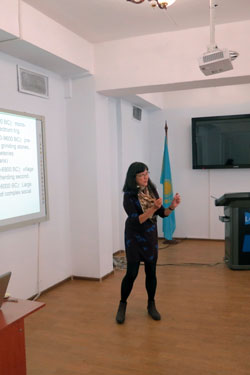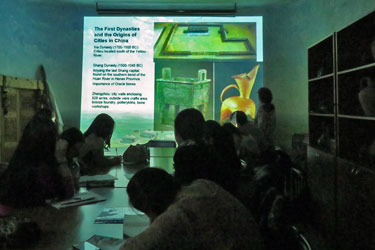Lessons from the Field
October 25, 2015I learned to teach at Sweet Briar College… when I first arrived in 1981 and on the first day of class I sat at the seminar table in Benedict. One of my favorite students Nicole said, “we didn’t even know who the teacher was, you were so young.” Teaching was hard work, the Physical Anthropology course included a text with 14 chapters, by Thanksgiving we reached Chapter 8. I was in big trouble, but I learned the hard way…human evolution would have to stop at Homo erectus. The Sweet Briar students were forgiving, no one complained and some even told me they liked the course.

Claudia Lecturing at Kazakh National University
I am telling you this by way of saying that if I hadn’t learned those hard lessons I would find the lecturing assignment at Kazakh National University for these two weeks at the end of October daunting. It is one thing to hold seminars or lectures to Sweet Briar students, but another thing to speak in Russian non-stop. I did not learn Russian language formally, in fact I speak “dig Russian” and “kitchen Russian,” the kind of language training that just comes informally through conversations.
These are the hard lessons I learned from 34 years of teaching some of the finest students I have ever taught (that is you Vixens…):
- Never assume that your points are clear to those who are listening.
- A quiet or unassuming student sometimes absorbs a whole lot more than the class know-it-all.
- Make jokes, even ones that are self-deprecating. Students like to imagine that their teachers are fallible like the rest of us.
- Always admit a mistake, don’t cover it up.
- Acknowledge the worth of every student, even the ones who drive you nuts because you never can predict how students turn out in their later lives.
- And above all be kind and generous in embracing intellectual development. Not everyone progresses at the same rate, nor is interested in the material you present.

Presenting: The Rise and Fall of World Civilizations
These lessons are serving me well this week. I have blundered through my Powerpoint slides on the Rise and Fall of World Civilizations. I have noted the puzzlement on the MA and PhD students’ faces when I slaughter another Russian pronunciation. We have had great discussions. The brilliant field archaeologist Alpina from Central Kazakhstan, a specialist in Bronze Age settlements, has examined slides of our excavations at Tuzusai and Taldy Bulak, re-interpreting some of our kiln features. The sweet MA exchange student from Hungary has corrected me about the Renfrew’s theory on the ‘wave and advance of Neolithic agriculture into Europe’ by telling me about the finds from the Central Plain of Hungary demonstrate that some Neolithic sites pre-date those in Greece and therefore undermine Renfrew’s diffusionist ideas correlating the spread of Indo-European language with the advance of Neolithic farming economies from the Near East into Europe. Then there is the Afghan student who will receive his MA in Archaeology from KNU and return to his hometown of Bamiyan where he will teach archaeology at Bamiyan University. Bamiyan is the site of the giant Buddhas carved into the hillsides, destroyed by Taliban.
As Sweet Briar College works towards expanding its international focus, both for attracting international students and for giving its own US students a global perspective, I think about the wonderful opportunity I have had teaching Kazakh students at the National Kazakh University of Al-Faraibi in Almaty (the largest city in Kazakhstan). I have brought to the department an American perspective on world archaeology and they have given me lots of consider for my own research. And more than that, they have reminded me of our Sweet Briar graduates, many of whom have made the focus of their lives — international studies. It has been humbling to have this experience and it has been a pleasure to share it with the Sweet Briar Community.